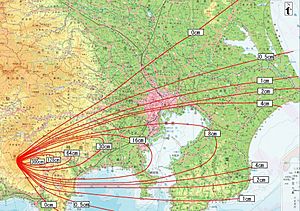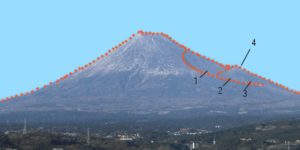Hōei eruption facts for kids
Quick facts for kids Hōei eruption |
|
|---|---|
 |
|
| Volcano | Mount Fuji |
| Type | Plinian eruption |
| Location | Chūbu region, Honshu, Japan 35°21′29″N 138°43′52″E / 35.3580°N 138.7310°E |
| VEI | 5 |

Map of volcanic ash fall during the Hoei eruption
|
|
The Hōei eruption was a huge volcanic explosion from Mount Fuji in Japan. It started on December 16, 1707, and lasted until February 24, 1708. This was the last time Mount Fuji had a confirmed eruption.
The eruption is famous for the massive amount of ash it spread across eastern Japan. This ash caused many problems, including landslides and widespread hunger. The area where the eruption happened is now called Mount Hōei. You can still visit the main crater of this eruption today.
Contents
What Happened During the Hōei Eruption?
Before the eruption, there were warning signs. Three years earlier, in 1704, rumbling sounds were heard. About one to two months before the eruption, strong earthquakes shook the area around Mount Fuji. Some of these earthquakes were quite powerful.
The eruption itself was a type called a Plinian eruption. This means it was very explosive. It shot out pumice (lightweight volcanic rock), scoria (dark, bubbly volcanic rock), and ash. These materials were thrown high into the stratosphere, which is a layer of Earth's atmosphere.
The ash then rained down far to the east of the volcano. This eruption was very powerful and is rated a 5 on the Volcanic Explosivity Index (VEI). The VEI measures how big volcanic eruptions are.
Where Did the Eruption Happen?

The Hōei eruption happened on the east-northeast side of Mount Fuji. It created three new openings, or vents, in the volcano. These are called No. 1, No. 2, and No. 3 Hōei vents.
The disaster unfolded over several days. First, there was an earthquake, followed by an explosion of cinders and ash. A few days later, even more rocks and stones were forcefully ejected. This event caused the worst ashfall disaster in Japan's history.
Even though no lava flowed, the eruption released about 800 million cubic meters of volcanic ash. This ash covered huge areas around the volcano. It even reached Edo (which is now Tokyo), nearly 100 kilometers away. In Edo, the ash was several centimeters thick. The ash covered many farms, stopping crops from growing. We don't know exactly how many people died from the eruption itself.
How Did the Eruption Affect People?
The Hōei eruption had a terrible impact on the people living near Mount Fuji. The ash and other volcanic material, called tephra, ruined farms. This led to a huge drop in food production. Many people in the Fuji area died because they couldn't get enough to eat.
Farmers tried to clean their fields by moving the volcanic ash into big piles. But when heavy rains came, the ash washed from these piles into rivers. This made some rivers, especially the Sakawa River, much shallower. The ash even created temporary dams in the rivers.
On August 7-8, 1708, the year after the eruption, very heavy rainfall caused a huge avalanche of volcanic ash and mud. This mudslide broke the ash dams in the rivers. It then flooded the Ashigara plain, causing even more damage.
Many people died not just from the eruption itself, but from the floods, landslides, and hunger that followed. The ash and large rocks made it hard for people to move to safer places. This meant more people in the Edo area suffered from starvation.
What Caused the Hōei Eruption?
Scientists believe the Hōei eruption was caused by two big earthquakes. One was the Genroku earthquake in 1703, and the other was the Hōei earthquake in 1707. The Hōei eruption happened just 49 days after the Hōei earthquake.
Mount Fuji has a system of cracks, called dikes, that go deep underground. These dikes act like pipes for magma (molten rock) to travel up to the surface. Deep inside the volcano, there are magma chambers filled with different types of magma.
The Genroku earthquake put pressure on these dikes and magma chambers. It squeezed them, trapping the magma inside. The magma was under great pressure, but it wasn't enough to cause an eruption yet.
Then, the Hōei earthquake happened. This earthquake changed the pressure again. It helped release the deepest magma, which was a type called basaltic melt. This basaltic magma then rose and mixed with the trapped magma closer to the surface. When different magmas mix, it can cause them to expand and create gas bubbles. This expansion and bubbling helped the magma push its way up to the surface, causing the Hōei eruption.
It's important to remember that other things might have also played a role. The eruption happened 49 days after the earthquake, which suggests there were other processes happening underground during that time.
Is Mount Fuji Still a Threat?
Japan is located in a very active part of Earth called The Ring of Fire. This area has many volcanoes and earthquakes. Mount Fuji sits where three large tectonic plates meet: the Eurasian, North American, and Philippine Sea plates. This is why the area has so much geological activity. The Hōei eruption happened after a very strong earthquake, and many volcanologists think the earthquake caused the eruption.
Scientists have been watching Mount Fuji closely. In 2012, they measured the pressure inside the volcano. This led to ideas that another eruption might happen. There have been many earthquakes near Mount Fuji since 1707. Some small activity was seen in the 1980s, 2000, and 2001. The big Tohoku earthquake in 2011 also caused some changes.
After the activity in 2000, scientists found that magma was collecting under the volcano. If another eruption like the Hōei one were to happen, it could cost Japan over US$25 billion. Experts think it would likely erupt from the same vents as the 1707 eruption.
A repeat of the Hōei eruption would affect over 30 million people. This includes people in busy cities like eastern Tokyo, Kanagawa, Chiba, and parts of Yamanashi, Saitama, and Shizuoka. Tokyo would be hit hard, possibly losing power and water, and its high-tech systems might stop working.
Mount Fuji has more than 20 stations that monitor ground movement. It's impossible to know exactly when the next eruption will happen. However, because it has been quiet for so long, many believe it could erupt again soon.
See also
 In Spanish: Erupción del monte Fuji de la era Hōei para niños
In Spanish: Erupción del monte Fuji de la era Hōei para niños
- 1707 Hōei earthquake
- Historic eruptions of Mount Fuji
- Mount Hōei


